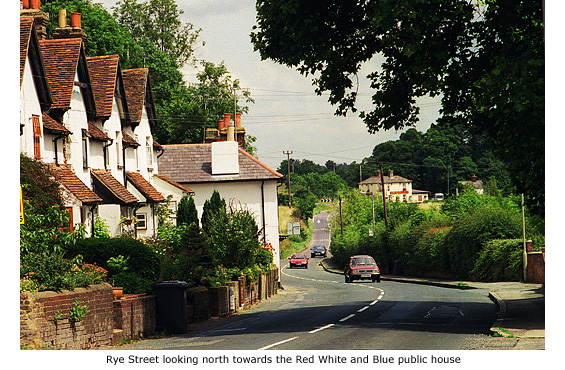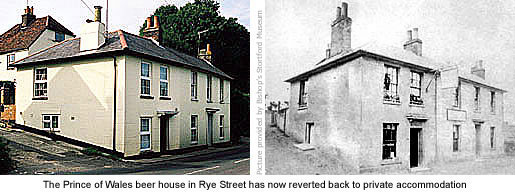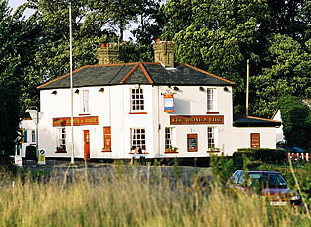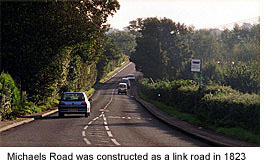|
|
|
 |
|
|
|
|
|
|
|
Crabbs Cross
|
|

Although you’ll never hear it mentioned today, the junction of Cannons Mill Lane with Rye Street was formerly called Crabb’s Cross, the name borne in the Middle Ages by the fact that a cross stood here marking this spot as the town’s northern boundary. The last reference to the name was made in 1803 in the Minute Book of the Rectory of Stortford. SEE 1823 MAP
Like Collin’s Cross in Stansted Road (See Guide 10), the origin of the name probably stems from a local person; Crabb or Crabbe being a common surname at that time and frequently mentioned in early churchwardens accounts.
The fact that fields to the east of Rye Street – from this point to beyond the present day Red White and Blue public house – were named Crabb’s Field, Crabb’s Croft and Crabb’s Croft Mead, seem to endorse the theory for the naming of the cross.
The actual site of the cross isn’t known but it probably stood close to the small, humpback bridge that takes Rye Street over Bourne Brook – a tributary of the river Stort but now little more than a ditch. Early maps of the area indicate this watercourse as an Ancient Way running from east to west, and once the original road to Farnham. The route, now lost to fields, would have created a crossroads at this point and was all the more reason to site the cross here. MORE PICTURES
|
|
|
|
 |
|
|
|
During the 18th and 19th centuries, beer houses in and around Bishop’s Stortford seemingly sprang up over-night. Many establishments were indigenous to the town’s malting industry, but with no regulation in licensing laws anybody could trade in beer and many opened up their own houses to do just that. It was a profitable business, mainly due to the fact that water was not particularly safe to drink and virtually everybody, including children, drank beer or spirits.
The perfect example of a private home being opened as a beer house stands opposite Cannons Mill Lane. In the 1800s, two terraced cottages (No’s 207 & 209 Rye Street) were combined to form the Prince of Wales public house – also know as the Odd Trick. In 1867 the landlord was Joseph Burles, but little else is known of the pub or of when it closed. Although the cottages are now privately owned their outward appearance has changed very little since that time. MORE PICTURES
|
|
|
|
Red White & Blue
|
|
  A familiar landmark for nigh on 150 years, the Red, White and Blue public house at the junction of Hazel End, Rye Street and Michaels Road, finally ceased trading in 2007 – yet another victim of new laws affecting the trade of public houses and people's ever-changing social habits. A familiar landmark for nigh on 150 years, the Red, White and Blue public house at the junction of Hazel End, Rye Street and Michaels Road, finally ceased trading in 2007 – yet another victim of new laws affecting the trade of public houses and people's ever-changing social habits.
The story goes that this Victorian property was built by a local landowner, who then gifted it to his son when he returned from the Crimean War (1853–1856). Grateful as he no doubt was, the son later turned the house into a pub and is said to have named it the Red White and Blue after the flagship of the fleet that was involved in the Crimean campaign. The only fault with this story, according to official naval records, is that no ship going by this name has ever been commissioned.
Another theory on the pub's naming, albeit even more tenuous, suggests a link with the Revolutionary War of the late 18th century, and the the practise of flying red, white and blue pennants on Dutch naval ships to denote an admiral's rank.
Assuming the date of the property's construction is correct, and that it was owned around that time by a veteran of the Crimean War, it would seem more likely the name is an allusion to a song apparently made popular during the Crimean War called ‘Hurrah! for the Red, White and Blue'.
Earliest record of the pub came in 1854 when it was conveyed to brewers, EKO Fordham. In the 1930s there was sawdust on the floors and gas lamps around the dartboard, but it was modernised in the 1950s and again in the 1990s when a small extension was added for dining facilities. Despite this the pub never regained its early popularity and after standing empty for almost two years, was bought in early 2009 by a private investor. Renovation and alteration including a larger extension followed and in November 2009 it reopened as a rather stylish Indian restaurant named Mountbatten – the Viceroy's Lounge. The origin of this name would seem to be a lot simpler; Lord Louis Mountbatten (1900–1979) being the the last Viceroy of India, who in 1947/8 oversaw the independence of India and Pakistan.
Some years ago, when drain digging was being carried out near to the property, workmen accidentally came across two Stone Age axes made of flint. These proved to be at least a quarter of a million years old and were proof that man lived in this area during the Ice Age. MORE PICTURES
|
|
|
|
Michaels Road
|
|
 During the 18th century Rye Street and the Manuden Road were in a constant state of bad repair, the damage caused mainly by heavy carts bringing grain into the town for malting. A petition by locals in 1790 brought about an Act in 1791 that enabled the Hockerill Turnpike Trust to build a link road between Manuden Road and the Newmarket Road (now Stansted Road), but not until 1823 was it finally built. With usual unimaginative thinking the road was first called ‘New Road’ then, later, St Michael’s Road. More recently it was changed to just Michaels Road – though why it was spelt this way is anybody's guess. During the 18th century Rye Street and the Manuden Road were in a constant state of bad repair, the damage caused mainly by heavy carts bringing grain into the town for malting. A petition by locals in 1790 brought about an Act in 1791 that enabled the Hockerill Turnpike Trust to build a link road between Manuden Road and the Newmarket Road (now Stansted Road), but not until 1823 was it finally built. With usual unimaginative thinking the road was first called ‘New Road’ then, later, St Michael’s Road. More recently it was changed to just Michaels Road – though why it was spelt this way is anybody's guess.
Construction of the link road necessitated the building of a bridge across the river Stort, but after six years of constant use by heavy traffic it was declared unsafe. Problems then arose over whose responsibility it was to repair the bridge because the river at this point acts as the border between Essex and Hertfordshire and, in theory, meant that each half of the structure belonged to a different county. Arguments ensued, and while each county steadfastly refused to pay for repair, some traffic reverted to the old route and others gained access to the Newmarket Road via Hockerill. The dispute was finally resolved two-and-a-half years later when a Bill of Indictment against Essex resulted in rapid repair work and the road finally re-opened in November 1832.
Eleven years later, when the railway line from Bishop’s Stortford was extended to Newport, traffic in Michaels Road was once again disrupted for the building of a railway bridge. MORE PICTURES
|
|
|
|
[ BACK TO TOP ] |
|
|
|
|
|
|
|
|
|






 A familiar landmark for nigh on 150 years, the Red, White and Blue public house at the junction of Hazel End, Rye Street and Michaels Road, finally ceased trading in 2007 – yet another victim of new laws affecting the trade of public houses and people's ever-changing social habits.
A familiar landmark for nigh on 150 years, the Red, White and Blue public house at the junction of Hazel End, Rye Street and Michaels Road, finally ceased trading in 2007 – yet another victim of new laws affecting the trade of public houses and people's ever-changing social habits. During the 18th century Rye Street and the Manuden Road were in a constant state of bad repair, the damage caused mainly by heavy carts bringing grain into the town for malting. A petition by locals in 1790 brought about an Act in 1791 that enabled the Hockerill Turnpike Trust to build a link road between Manuden Road and the Newmarket Road (now Stansted Road), but not until 1823 was it finally built. With usual unimaginative thinking the road was first called ‘New Road’ then, later, St Michael’s Road. More recently it was changed to just Michaels Road – though why it was spelt this way is anybody's guess.
During the 18th century Rye Street and the Manuden Road were in a constant state of bad repair, the damage caused mainly by heavy carts bringing grain into the town for malting. A petition by locals in 1790 brought about an Act in 1791 that enabled the Hockerill Turnpike Trust to build a link road between Manuden Road and the Newmarket Road (now Stansted Road), but not until 1823 was it finally built. With usual unimaginative thinking the road was first called ‘New Road’ then, later, St Michael’s Road. More recently it was changed to just Michaels Road – though why it was spelt this way is anybody's guess.